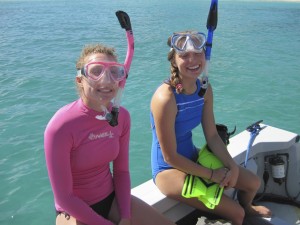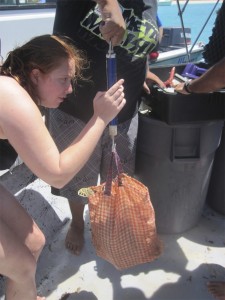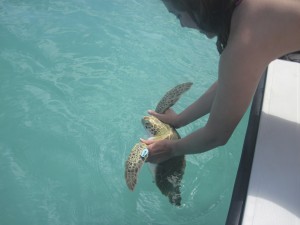It all began at 9 am on Thursday morning. We all piled into two boats and traveled out to Tortuga Bay at Culebrita Island for some green sea turtle field research. The water was super clear and we could easily see the turtles as well as tons of other wildlife including sting rays (see picture below) and fish. We also snorkeled over a coral reef!



We started by setting a tangle net across the bay to catch the green sea turtles. The group split into partners and half the group attempted to chorale the turtles to the net while the second half of the group patrolled parallel to the nets to watch for entangled turtles. Once a pair found an entangled turtle, one person dove down to bring the turtle to the surface while the other person helped untangle the turtle (of course we called for help when needed!). All caught turtles were handed off to the boat for later examination. After an hour of hard patrolling we collected the net and piled back onto the boat to examine the turtles.

We caught 8 turtles on our first try! One boat was used to tag and measure the turtles while the other boat was used for physical examinations, photo-IDs, and releases.
Tagging Boat: First we checked the turtle for past flipper tags and PIT tags with a scanner and gave the turtle tags if it did not already have them. The tags we used were flipper tags (metal and/or plastic) and PIT tags (which are about the size of a grain of rice and are injected internally under the skin). We had two flipper tags in case one tag falls off and PIT tags in case both flipper tags fall off. Also, you need to had a scanner to read the PIT tags; therefore, flipper tags are easier to read and record. After tagging the turtle we took measurements of its carapace length and weighed the turtle. After each turtle was tagged, measured, and weighed, we sent the turtle to the next boat!






Physical Examination Boat: On this boat, we visually inspected the carapace and plastron sides of the turtles (paying particular attention to possible Fibropapilloma tumors). We also took photo-ID pictures of each turtle with its tag numbers and the date written on a piece of paper next to it. One turtle had potential FP tumors, so we took samples of these possible tumors for later analysis. After each turtle was examined we took turns releasing them back to the big blue! It was exhilarating!


After a quick lunch of PB&J we returned to the water to repeat the whole process for another hour. This time we caught another 8 green sea turtles! We returned to the house around mid afternoon and quickly took showers and power naps before heading out for a marvelous dinner at Dinghy Dock.
When we returned to the house, Carlos gave us a lecture on the research being conducted in Puerto Rico (including Culebra Island and Mona Island). Puerto Rico is an important foraging area for juvenile green and hawksbill sea turtles and an important nesting site for leatherback and hawksbill sea turtles. We also learned that research on foraging green sea turtles has been happening in Culebra since 1987! Though we were all tired we packed up our warm clothes and piled into the jeeps to travel to Zoni Beach to monitor for nesting leatherbacks. We monitored the beach in two groups, taking turns so we could sneak in naps on the sand. Though we did get to see previous nests that were roped off for future monitoring, we did not see any leatherbacks 🙁 However, it was an early night so we are still hopeful to see a leatherback in upcoming nights!
Abigail Kucher and Angela Woods


